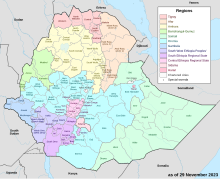Mehakelegnaw Zone
Demographics

Based on the 2007 Census conducted by the Central Statistical Agency of Ethiopia (CSA), this Zone has a total population of 1,245,824, of whom 613,797 are men and 632,027 women; 176,453 or 14.16% are urban inhabitants. The largest ethnic group reported in the Central Zone was the Tigrayan (99.37%); all other ethnic groups made up 0.63% of the population. Tigrinya is spoken as a first language by 99.4; the remaining 0.6% spoke all other primary languages reported. 97.82% of the population said they were Orthodox Christians, and 2.07% were Muslim.
The 1994 national census reported a total population for the zone of 943,850, of whom 464,633 were men and 479,217 women; 91,058 or 9.6% of its population were urban dwellers. The Zone is predominantly Tigrayan, at 99.6% of the population, while 0.11% were Agaw, 0.096% Amhara, and all other ethnic groups 0.12%. Tigrinya was spoken as a first language by 99.67% of the inhabitants. 98.41% of the population said they were Orthodox Christians, and 1.55% were Muslim. Concerning education in the Zone, 9.64% of the population were considered literate; 10.62% of children aged 7–12 were in primary school, while a negligible number of the children aged 13–14 were in junior secondary school, and 0.14% of children aged 15–18 were in senior secondary school. Concerning sanitary conditions, about 25% of the urban and 5.6% of all houses had access to safe drinking water at the time of the census; about 2.5% of the urban and 6% of the total had toilet facilities.
According to a May 24, 2004 World Bank memorandum, 13% of the inhabitants of the Central Zone have access to electricity, this zone has a road density of 29.0 kilometers per 1000 square kilometers, the average rural household has 0.8 hectare of land (compared to the national average of 1.01 hectare of land and a regional average of 0.51) and the equivalent of 0.8 heads of livestock. 17% of the population is in non-farm related jobs, compared to the national average of 25% and a regional average of 28%. 74% of all eligible children are enrolled in primary school, and 28% in secondary schools. 78% of the zone is exposed to malaria, and none to Tsetse fly. The memorandum gave this zone a drought risk rating of 616.
References
- ^ Census 2007 Tables: Tigray Region Archived November 14, 2010, at the Wayback Machine, Tables 2.1, 3.1, 3.2, 3.4.
- ^ The 1994 Population and Housing Census of Ethiopia: Tigray Region Archived December 7, 2008, at the Wayback Machine, vol. 1, part 1: Tables 2.1, 2.11, 2.14
- ^ Comparative national and regional figures comes from another World Bank publication, Klaus Deininger et al. "Tenure Security and Land Related Investment", WP-2991 Archived 2007-03-10 at the Wayback Machine (accessed 23 March 2006).
- ^ World Bank, Four Ethiopias: A Regional Characterization (accessed 23 March 2006).